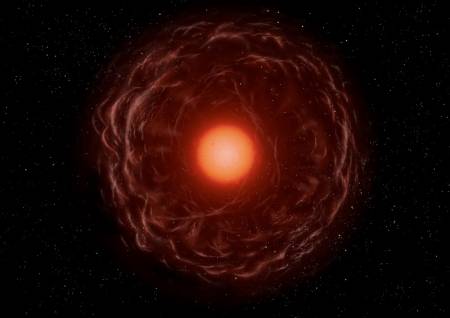
Life will have fried, oceans will have boiled away, but no one has ever been sure what will happen to Earth itself when the Sun finally swells into a red giant. Now, astrophysicists from Mexico and the UK are forecasting a dismal fate for our rocky planet: it will get caught up in the Sun’s outer layers, spiral inwards and vaporize.
Like all dwarf stars, the Sun converts hydrogen nuclei into helium nuclei by fusion to produce immense amounts of radiation and outward pressure. But in five billion years or so the core will run out of hydrogen fuel, lose pressure and collapse under its own gravity. As this inward crush boosts the temperature of the core, the remaining shell of hydrogen around it will heat up and trigger a new period of fusion, which in turn will cause the Sun’s outer envelope to expand to around 250 times its current radius and cool from white to red.
Once the Sun is in this red-giant phase, Mercury will certainly be engulfed, and going on the increase of the Sun’s radius alone it would appear that Venus, Earth and Mars will suffer the same fate too. During expansion, however, the Sun is also expected to shed mass in a powerful solar wind. The resultant drop in gravity will let the orbits of the planets drift outwards, and some models suggest that Earth — and possibly Venus — might escape the fiery death. Indeed, astrophysicists have even spotted a distant solar system in which a planet with Earth’s orbital radius has survived its star’s red giant phase.
Klaus-Peter Schroeder of Guanajuanto University and Robert Smith of Sussex University are not so optimistic. They have performed calculations of Earth’s fate that include not only the favourable effects of solar mass loss, but also the speed of the Sun’s rotation, which will diminish as the Sun gets bigger. Currently completing one rotation in about a month, at red-giant size the Sun will rotate once every few thousand years, allowing the Earth’s gravity to draw out a large tidal bulge on the solar surface. Such a bulge will haul the Earth back into the Sun’s outer layers, while the drag will steadily reduce the rocky planet’s orbital angular momentum. Earth will spiral inwards until it eventually vaporizes (Mon. Not. R. Astron. Soc. to be published; preprint available at arXiv:0801.4031).
We would say this is the definitive answer to the fate of the Earth Robert Smith, Sussex University
A history of fates
This is not the first time that tidal bulges have been taken into account when predicting Earth’s fate. In 1996, Mario Livio at the Hubble Space Telescope Science Institute and colleagues also found that the effect would be strong enough to swallow up Earth. Then, in 2001, Kacper Rybicki of the Polish Academy of Sciences and Carlo Denis of the European Centre for Geodynamics and Seismology in Luxembourg suggested that the Earth would survive in spite of tidal bulges.
But Rybicki and Denis’s analyses were mostly qualitative, while the calculations performed by Livio’s group were based on an old formula for the Sun’s mass loss. Schroeder and Smith, on the other hand, have performed their calculations using a recent mass-loss equation devised by Schroeder along with Manfred Cuntz from the University of Texas at Arlington, which was calibrated using precise observations. “We’re confident that our mass-loss equation is the best that’s currently available,” Smith told physicsworld.com. Furthermore, Schroeder and Smith have consulted with Jean-Paul Zahn of the Paris Observatory, who is regarded as the authority on tidal physics, to make sure they have considered the effect of tidal bulges properly.
Still, predictions for the fate of the Earth have bandied about for decades, so is this the final say in the matter? “We would say this is the definitive answer to the fate of the Earth,” says Smith. “But I dare say someone will come up in a few years and say that we’re wrong.”
Smith points out, however, that any further developments will likely come to the same conclusion because he and Schroeder have “probably underestimated” the total drag. The solar wind, which the pair did not include in their calculations, should also hinder the motion of the Earth in its orbit and encourage it to spiral inwards.



